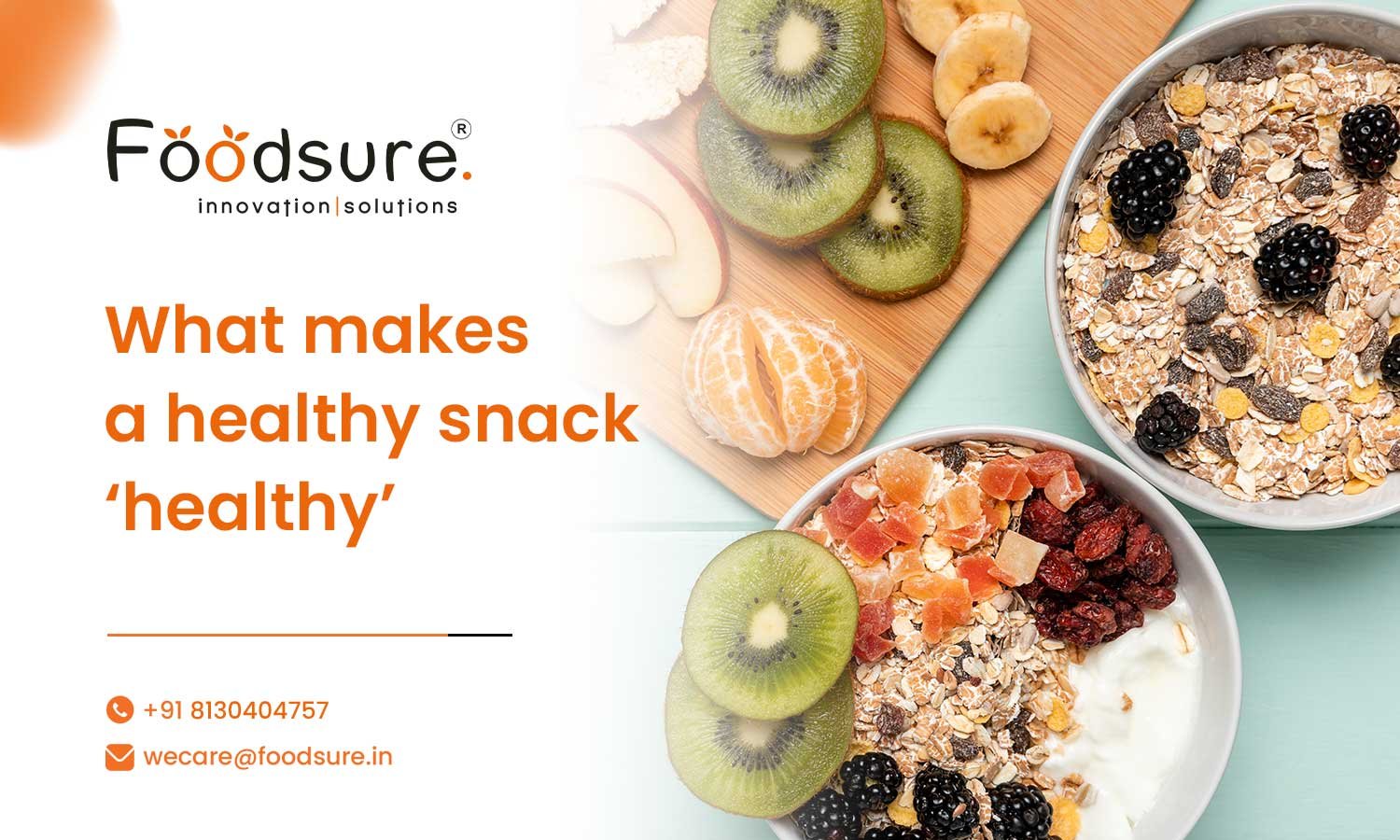The term “healthy snack” is so popular nowadays that it’s started to lose its real meaning, leaving shoppers confused and making things tough for FMCG brands. Having worked closely with the industry, we have seen how much people’s expectations have changed. Simply calling something “healthy” is not what consumers want. Real health comes from a smart mix of solid nutrition, honest ingredients, and truly listening to what people want. For any food company who wants to stand out in the market, figuring out what actually makes a healthy snack ‘healthy’, is what really sets you apart.
Pillars That Make A Healthy Snack ‘Healthy’
The function of a healthy snack is to provide good nourishment without too much of ingredients that we can avoid. A healthy snack recipe formulation doesn’t mean to count calories but about the quality of those calories and their impact on the body.
Density of the Nutrients
A protein-rich snack product development packs a nutrient punch. It gives a good amount of vitamins, minerals, fiber, and beneficial macronutrients, like protein, healthy fats, complex carbohydrates, compared to its calorie count.
- Balanced Micronutrients- The snack recipe formulation experts add a good mix of macronutrients to the snack formulation. A good healthy snack should combine:
- Complex carbohydrates
- Healthy fats
- Protein
- Power of micronutrients- A snack is truly healthy when it is full of micronutrient-rich snack development, like vitamins (A, B, C, D) and minerals (iron, calcium, magnesium). Food brands should focus on ingredients naturally rich in these micronutrients, or think about adding them responsibly where it makes scientific sense and meets regulations.
‘Clean-Label’ Snacks
People are reading ingredient lists of snacks properly for health concerns, and so your snack must contain functional snack ingredients. A clean-label snack formulation means:
- Natural Ingredients: Whole, unprocessed foods have the ability to keep their natural nutrients. While the highly processed snacks mostly lose their goodness during making and pick up unnecessary additives. So, it is better to choose less processed functional ingredients for snacks.
- Less Added Sugars: Many snacks that pretend to be healthy are loaded with added sugars, mostly hidden with different names, like maltodextrin, cane syrup, and fruit juice concentrate. The FDA’s new “healthy” standard sets clear limits for added sugars. Brands need to aim for less or no added sugars, depending on natural sweeteners for snacks from fruits or subtle, natural alternatives.
- Low Sodium and Saturated Fat: Too much sodium and saturated fat can result in various health issues. Healthy snacks should be made with these limits in mind, sticking to dietary advice that warns against snacks high in these components.
- No Artificial Additives: Artificial colors, flavors, preservatives, and sweeteners are red flags for many health-conscious consumers. Opting for natural choices and gentler ways to preserve food is important.
Portion Control for a Healthy Snack
Even the most nutritious snack can become unhealthy if we eat too much. This is a common problem with pre-packaged snacks, where large bags mostly get eaten in one sitting.
- Single-Serve Sizes: Providing snacks in properly sized individual portions helps people manage how much they eat.
- Calorie Awareness: While not the only measure of health, a sensible calorie range for a snack (usually 100-250 calories) is helpful to avoid taking in too much energy between meals.

Consultant Tips For FMCG Brands
More than science, making successful healthy snacks means understanding market trends and what people love.
Ingredient Choices and New Ideas
- Implement Functional Ingredients- More than basic nutrition, shoppers are looking for snacks that provide specific health benefits. This is where functional ingredients help:
- Probiotics and Prebiotics- fermented dairy, chicory root fiber, and inulin help to support gut health.
- Adaptogens- Ashwagandha or reishi mushroom that helps with stress control.
- Traditional Grains and Millets- Sorghum, quinoa, amaranth, and ragi are great sources of fiber, protein, and micronutrients.
- Plant-based proteins- pea protein, chickpea flour, lentil-based snacks, and nut options
- Sustainable Sourcing- People are increasingly valuing ethical and eco-friendly practices. Highlighting sustainable sourcing, fair trade clean label certification for snacks, and less packaging can grow the brand’s appeal. Choose ingredients that have a lower environmental impact and support local communities when possible.
More Powerful Article: Top Snack Seasoning Formulation Trends For 2025
Know How People See Your Snack Product
- Research is important: Don’t just claim that your snack is “healthy”; explain the consumers why it is healthy. Use clear, simple language on packaging to point out key nutritional benefits.
- Taste Is The Main Factor: Even the healthiest snack won’t do well if it doesn’t taste good. Coming up with new flavors and textures is important to keep people coming back. Consider natural flavor enhancers to keep the taste and texture of the snack great.
- Targeted Options: Healthy snacking isn’t one-size-fits-all. Develop products made for specific needs:
- Kids’ Snacks: Focus on hidden vegetables, less sugar, and fun shapes.
- Post-Workout Snacks: Highlight protein for muscle recovery.
- On-the-Go Options: Make them easy to carry and eat anywhere.
- Gut-Friendly Snacks: Focus on probiotic and prebiotic content.

Following Rules and Regulations
- Keep Up with Regulations: Nutrition guidelines and labeling laws are always changing. Work with food formulation experts to make sure all claims are true and meet the rules in your target markets. This includes understanding the limits for added sugars, sodium, and saturated fats.
- Look Ahead to New Trends: The rise of customized nutrition suggests a future where snack suggestions might be customized to each person’s unique body. While still early for the general public, food brands should watch these developments and think about how they’ll innovate.
- Transparency and Where Food Comes From: People want to know where their food comes from. Having strong systems to track ingredients and being open about sourcing builds trust.
The Science of Feeling Full and Blood Sugar Impact
More than basic nutrients, understanding how ingredients affect how full we feel and our blood sugar is important.
- Fiber’s Role: Soluble and insoluble fibers help us feel full by slowing down digestion and adding bulk. Pectin (in apples), beta-glucans (in oats), and resistant starch (in beans) are great examples.
- Protein’s Filling Power: Protein makes us feel full more effectively and significantly impacts the hormones that control hunger, making protein-rich snacks very good at keeping hunger away.
- Low Glycemic Index (GI) Ingredients: Ingredients that cause a slower, more gradual rise in blood sugar (lower GI) prevent energy crashes and subsequent cravings. Whole grains, most fruits, and vegetables generally have a low GI.

Read More: Contract Manufacturing Of Healthy Snacks – Partner With Us!
Take the First Step Towards Healthy Snack Innovation That Consumers Want!
People are looking for healthy snacks that taste great and make them feel good. If you want your brand to stand out, focus on real ingredients, health benefits, and flavors that surprise and delight. Get connected with our healthy snack recipe formulation experts to make a successful healthy snack that is market-ready. Get guidance on how to market a healthy snack from our experts. Send us your query on +91 8130404757.
Start creating snacks your customers will truly love!




